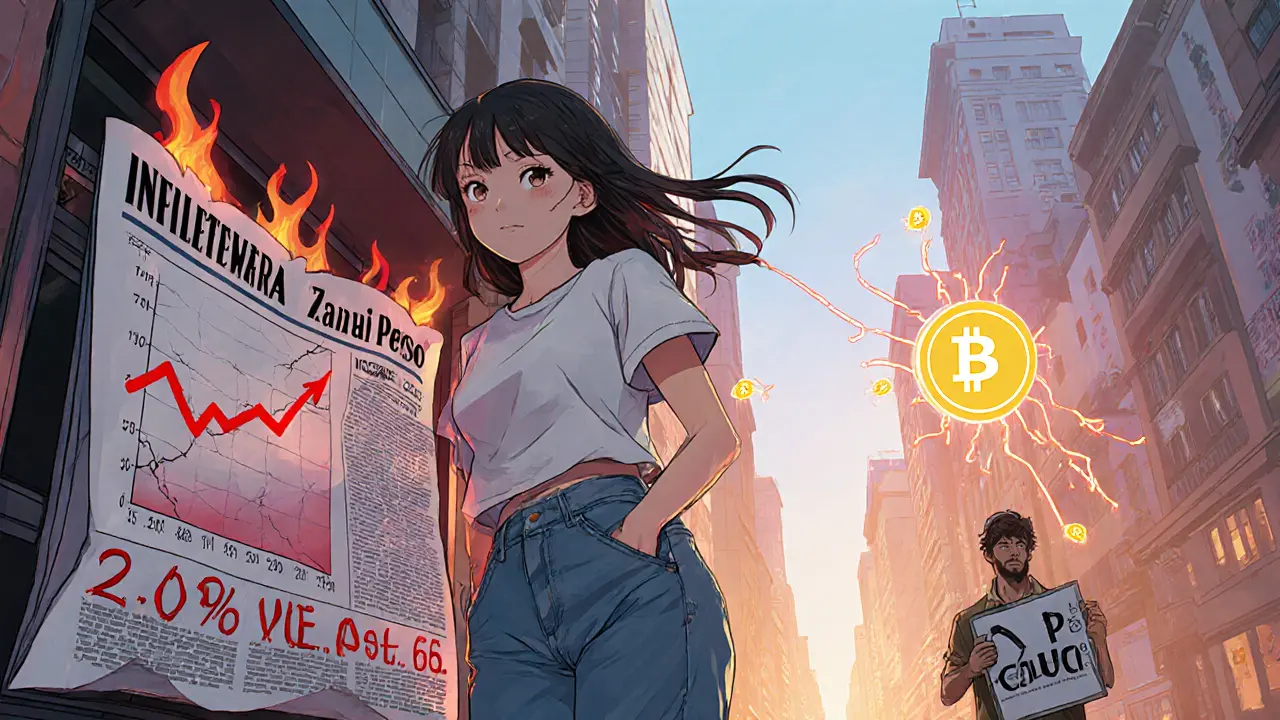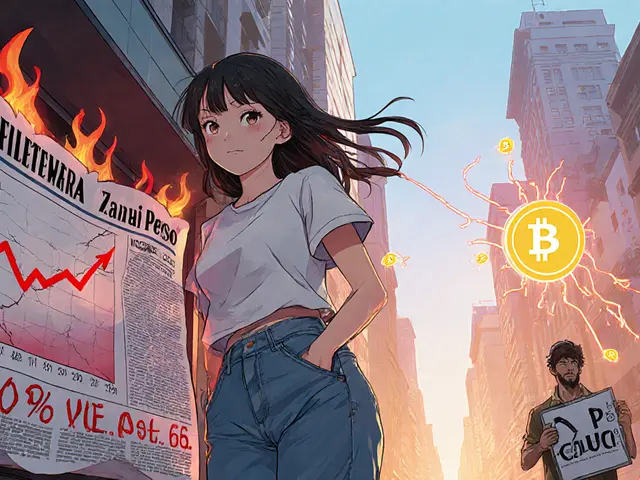Stablecoin Value Calculator
Convert Pesos to Stablecoins
Calculate how much your money would be worth in USDT or USDC after accounting for Argentina's high inflation rates. This tool helps you understand the real value of your savings.
Your Stablecoin Value
Current value at today's exchange rate
Inflation Impact
Value after 6 months at 40% annual inflation
40% annual inflation Your savings will lose 0% value in 6 months if kept in pesos
Current value in USD: $0.00 Value after 6 months in USD: $0.00
How Stablecoins Protect Your Savings
Stablecoins like USDT and USDC maintain value by being pegged to the US dollar. Unlike pesos that lose value due to high inflation (currently above 40%), stablecoins provide a reliable store of value.
| Feature | Stablecoins (USDT/USDC) | Argentine Pesos |
|---|---|---|
| Purchasing Power | Stable over time | Decreases 40%+ annually |
| Remittance Costs | Under 1% | 5-10% |
| Accessibility | Available 24/7 | Limited by capital controls |
| Regulatory Status | Regulated under CNV framework | No foreign currency accounts |
Note: This calculator uses Argentina's current inflation rate of 43.5% (as of May 2025) for projection purposes. Actual rates may vary.
Cryptocurrency adoption in Argentina is a financial‑technology movement that lets people store value in digital assets when the local currency loses its buying power. With annual inflation still above 40% in 2025, many Argentines have turned to crypto as a practical hedge against the peso’s rapid depreciation.
Why Inflation Pushes People Toward Crypto
Argentina has a long history of runaway price rises. The hyperinflation of 1989‑1990 peaked at 2,600% annually, and the country recorded 161% inflation in 2023 before easing to 43.5% by May 2025. Those numbers matter because every month a peso‑denominated salary buys less than it did the month before. Traditional banks offer almost no dollar‑denominated accounts due to strict capital controls, leaving a gap that crypto quickly fills.
Stablecoins: The Dollar‑Pegged Lifeline
Three stablecoins dominate Argentine wallets:
- Tether (USDT) - a fiat‑backed token that claims a 1:1 reserve of US dollars.
- USD Coin (USDC) - issued by the Centre consortium, audited monthly for dollar backing.
- DAI - an algorithmic stablecoin whose collateral is locked on the Ethereum blockchain.
All three act like a "digital dollar" that users can hold without needing a foreign bank account. Because their price stays within a tight band around $1, they protect savings from the peso’s 100%+ annual inflation.

How Platforms Turn Paychecks Into Stablecoins
The most popular on‑ramp is Lemon. The app links directly to a user’s payroll, converts the Argentine peso salary into USDC at the moment it lands, and stores the digital dollars in a custodial wallet. When the user wants to spend, Lemon issues a prepaid Visa debit card that draws instantly from the USDC balance, converting back to pesos at the point of sale. The result is a seamless bridge between local cash flow and dollar‑stable crypto.
International exchanges like Binance also play a big role. Users can buy Bitcoin for speculation, but the bulk of daily activity revolves around swapping pesos for USDT or USDC and moving those funds to their Lemon or other local wallets.
Real‑World Use Cases
Beyond just “saving”, crypto solves several everyday problems:
- Remittances - Families with members abroad receive stablecoins via apps, cutting fees from 5‑10% on traditional services to under 1% and delivering money in minutes.
- Purchasing power - A shopper can pay for groceries with a Visa card linked to USDC, avoiding the rapid price spikes that hit cash‑only transactions.
- Small business payments - Vendors accept stablecoins for goods, then convert to pesos when needed, keeping their margins intact.
One Buenos Aires mother shared on X that after converting her monthly salary to USDC, she could finally afford a three‑month supply of school supplies for her children-something her peso salary hadn’t covered in years.
Regulatory Landscape: From Uncertainty to a Framework
Until 2024, Argentina’s crypto scene operated in a gray zone. In March 2025, the National Securities Commission (CNV) issued Resolution 1058/2025, establishing licensing, AML, and reporting rules for exchanges and wallet providers. The move gave businesses legal certainty while still allowing users to move money freely.
President Javier Milei has repeatedly voiced support for digital assets, positioning crypto as a tool for “economic freedom”. Analysts believe that this pro‑crypto stance, combined with the new CNV framework, will keep Argentina at the forefront of Latin American crypto adoption.

Comparison of the Leading Stablecoins
| Stablecoin | Peg Mechanism | Backing Assets | Typical Platform | Regulatory Scrutiny (2025) |
|---|---|---|---|---|
| USDT | Fiat‑backed (1:1 USD) | Cash & short‑term securities | Binance, Lemon | High (frequent audits) |
| USDC | Fiat‑backed (1:1 USD) | US Treasury bonds, cash | Lemon, Coinbase | Medium (transparent reporting) |
| DAI | Collateralized debt position | Ethereum‑based assets (ETH, USDC) | MetaMask, decentralized exchanges | Low (decentralized governance) |
Future Outlook: What Comes Next?
As long as inflation stays double‑digit, the incentive to lock money in a dollar‑stable asset remains strong. Experts predict three trends:
- Deeper integration with traditional finance - More banks may partner with crypto wallets to offer hybrid accounts.
- Growth of local stablecoin projects - Argentine startups could launch peso‑backed stablecoins that combine local regulatory compliance with crypto flexibility.
- Exportable model - Countries like Turkey or Lebanon, also battling hyperinflation, are watching Argentina’s playbook for clues.
For now, the combination of high inflation, capital controls, and a budding regulatory framework makes crypto the go‑to savings tool for millions of Argentines.
Frequently Asked Questions
Can I open a US dollar bank account in Argentina?
No. Capital controls prevent most residents from holding foreign‑currency accounts. That’s why stablecoins like USDC act as a “digital dollar” you can hold without a bank.
Is crypto legal in Argentina?
Yes. Since 2024 the CNV regulates exchanges and wallet providers. Users can buy, sell, and spend crypto, but they must follow AML/KYC rules.
Which stablecoin should I choose for savings?
USDC is popular for its transparent audits, while USDT offers the widest market liquidity. DAI appeals to users who prefer a fully on‑chain collateral model.
How fast are remittance payments with stablecoins?
Transfers usually settle in minutes, compared with 3‑5 business days for traditional banks, and cost less than 1% in fees.
Will the Argentine government ban crypto?
Current policy under President Milei is pro‑crypto, and the CNV framework aims to regulate rather than prohibit. A full ban would face strong public and economic backlash.
The story of Argentina shows that when inflation erodes confidence in the local currency, people will turn to whatever tool lets them preserve purchasing power. For many, that tool is crypto, and stablecoins have become the everyday savings account of the digital age.









Comments (11)
Kyla MacLaren
October 14, 2025 AT 08:30 AMStablecoins are the only sane way to keep money from disappearing.
John Beaver
October 20, 2025 AT 12:30 PMI've been watching how Argentines are moving their savings into crypto for a while now, and the pattern is pretty clear. First, they take the pesos they earn each month and immediately convert them to USDT or USDC through local exchanges. The exchange rates can be volatile, but the stablecoin peg means they aren't losing value to inflation in the same way they would in a bank account. Second, many use peer‑to‑peer platforms to avoid the hefty 5‑10% remittance fees that the government imposes on traditional transfers. By sending stablecoins directly to a friend's wallet, the cost drops to under one percent, sometimes even less. Third, because stablecoins are accessible 24/7, people can react instantly to price spikes or policy changes, something you just can't do when your money is locked in a foreign‑currency account. Fourth, the crypto community in Argentina has built a whole ecosystem of support services – from tutorials on how to secure private keys to local meetups where people share tips on avoiding scams. Fifth, many businesses have started accepting USDT and USDC as payment, which means you can actually spend the stablecoins instead of having to convert back to pesos and pay the hidden tax. Sixth, the regulatory environment is still fuzzy, but the CNV (Comisión Nacional de Valores) has shown some willingness to create a framework that protects users without stifling innovation. Seventh, the psychological effect shouldn't be underestimated; knowing your savings aren't eroding by 40% a year gives people a sense of control. Eighth, for those who are tech‑savvy, using decentralized finance (DeFi) protocols to earn a small yield on their stablecoins can offset transaction costs. Ninth, the network effect keeps growing – as more people adopt, the liquidity improves, making it even easier to move large sums. Tenth, you still need to be careful about the exchange you choose; not all are reputable, and some have been known to freeze withdrawals. Eleventh, hardware wallets are a good way to keep your stablecoins safe from hacks, especially if you store a significant amount. Twelfth, the government occasionally tries to ban crypto brokers, but the community quickly finds workarounds. Thirteenth, many Argentines also keep a small stash in gold as an additional hedge, but the majority of daily transactions now happen on the blockchain. Fourteenth, the overall trend shows that crypto isn’t just a speculative fad here; it’s become a practical tool for everyday financial stability. Fifteenth, if inflation continues at its current pace, we can expect even more people to shift completely away from the peso.
Linda Campbell
October 26, 2025 AT 15:30 PMWhile one might argue that crypto is a reckless venture, the undeniable reality is that Argentina's fiscal policies have rendered the peso a vehicle of systematic decay. The state-sanctioned inflation rates, now surpassing forty percent annually, leave conventional savings instruments obsolete. Consequently, those with even a modicum of financial acumen have turned to assets that are, at least nominally, insulated from sovereign monetary manipulation.
EDMOND FAILL
November 1, 2025 AT 19:30 PMMan, the whole crypto thing in Argentina is wild. People just hop on the USDT train and never look back.
Jennifer Bursey
November 7, 2025 AT 23:30 PMThe macroeconomic volatility has catalyzed a rapid adoption curve for algorithmically stable assets, effectively creating a decentralized hedging layer against fiat devaluation.
Maureen Ruiz-Sundstrom
November 14, 2025 AT 03:30 AMIsn't it fascinating how a digital token can become the new lifeline for an economy teetering on the brink? The philosophical implications are profound.
Bruce Safford
November 20, 2025 AT 07:30 AMDon't you see the hidden agenda? Every time they push stablecoins they want control over our wallets. Wake up!
Shrey Mishra
November 26, 2025 AT 11:30 AMIn the grand theater of Argentina's economic saga, the rise of stablecoins is nothing short of a dramatic crescendo, echoing the nation's relentless quest for financial salvation amidst relentless inflation.
Ken Lumberg
December 2, 2025 AT 15:30 PMIt's morally indefensible that people have to resort to crypto just to preserve their hard‑earned money. The system is broken.
Blue Delight Consultant
December 8, 2025 AT 19:30 PMThough the trend appears beneficial, the long‑term regulatory ramifications remain uncertain, warranting cautious optimism.
Wayne Sternberger
December 14, 2025 AT 23:30 PMFrom a financial perspective, the shift to stablecoins mitigates exposure to hyperinflation, yet users must remain vigilant regarding custodial security.